The idea of an atomic blast ship proved to be unviable even before the first working model of such a vehicle was built. Therefore, people turned to less simple but safer and more stable methods to create an efficient space engine powered by a nuclear reaction, and began experimenting with reactive nuclear rocket engines.
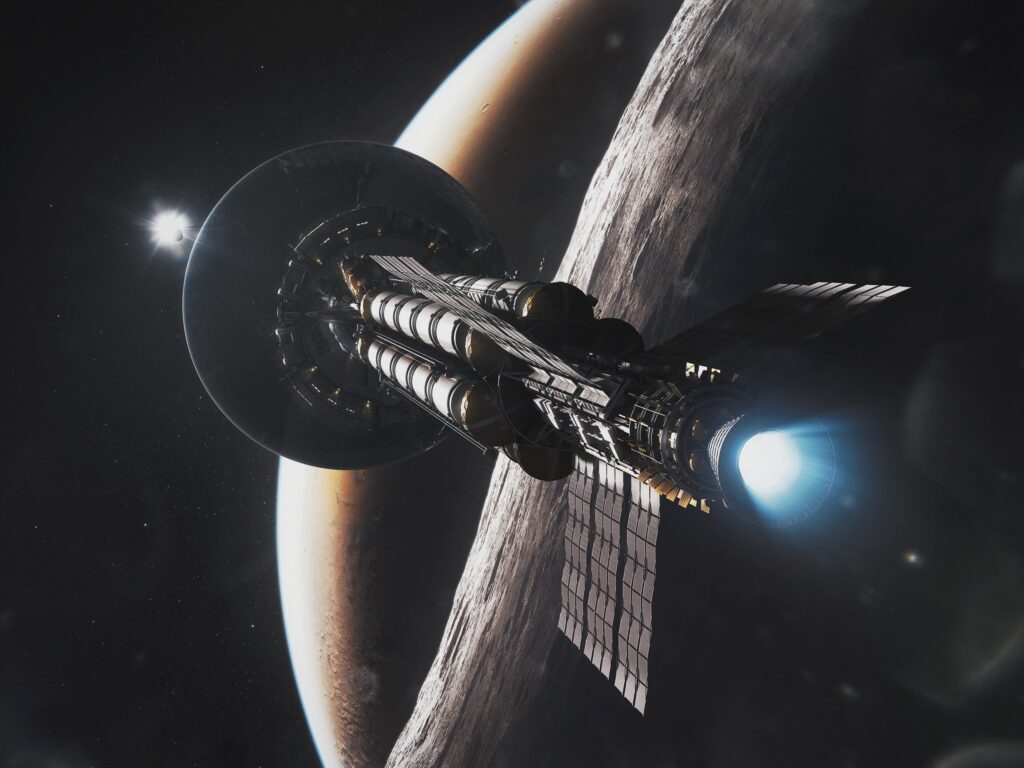
The simplest scheme of a nuclear engine
In fact, the nuclear jet engine is not such a complex unit. It basically utilizes the same expansion of gases due to heating as chemical engines, but since nuclear reactions can heat gas to much higher temperatures than chemical reactions, the rate at which the working fluid flows out of such an engine will be much higher. It basically utilizes the same expansion of gases due to heating as chemical engines, but since nuclear reactions can heat gas to much higher temperatures than chemical reactions, the rate at which the working fluid flows out of such an engine will be much higher. And the higher the rate — the higher the specific impulse.
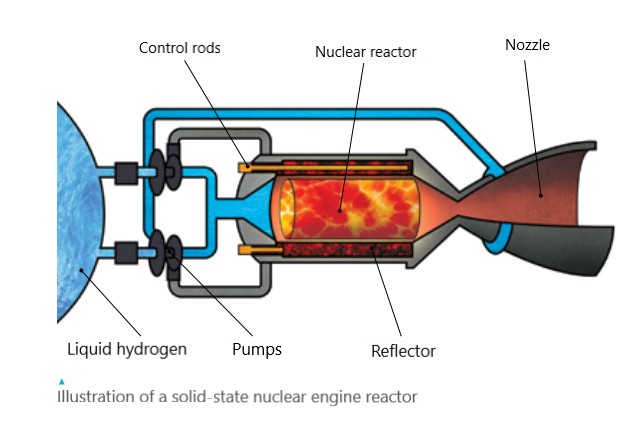
The theoretical scheme of the engine is as follows. Slabs are made of some uranium compound (as refractory as possible) and placed in a row at a small distance from each other. As the mass of the plates exceeds the critical mass, a chain reaction begins and the assembly becomes a nuclear reactor. A working fluid, usually liquid hydrogen, is fed in from one side of it. It absorbs excess energy from the slabs, acting as a reactor cooler, while heating itself. On the opposite side of the assembly is a nozzle through which hydrogen is ejected, creating thrust.
American nuclear engines
The practical development of this scheme began in 1955, at the same time as the development of a nuclear-powered blast ship. This project was called Rover. It was first handled by the Department of Defense and then by NASA. As part of the project, tests were conducted under the name KIWI. The nuclear engine assembled using the above scheme was tested under ground conditions.
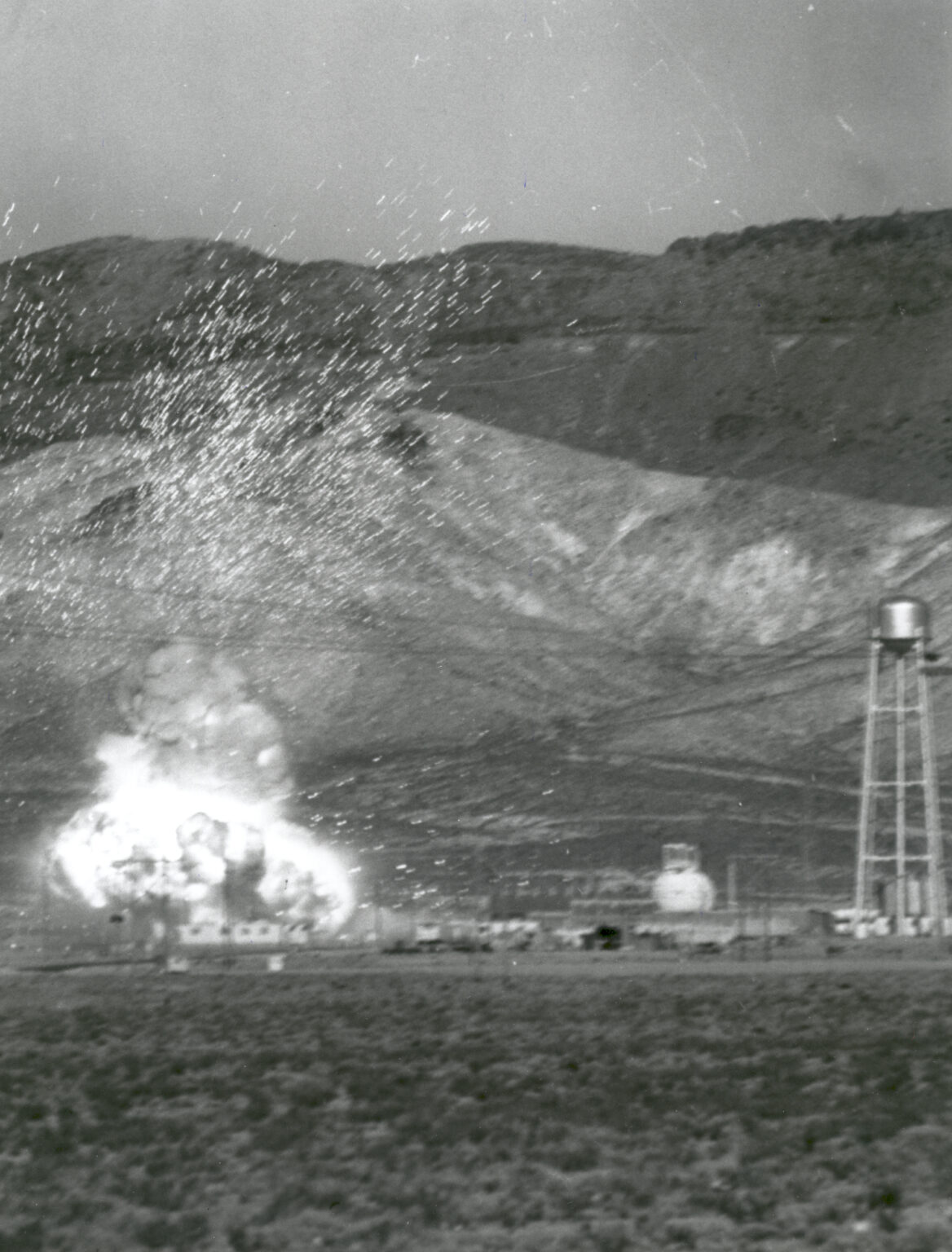
KIWI engine plates were first made of uranium oxide, then uranium dioxide was used, but the result was the same: the engine worked, produced thrust and even demonstrated specific impulse twice as much as the most advanced chemical rockets, and then exploded. It turned out that the hydrogen flow caused rapid corrosion of the plates. When they were replaced with more stable ones made of uranium carbide, this reduced the corrosion to a large extent, but did not stop it completely.
A continuation of the Rover project was NERVA (Nuclear Engine for Rocket Vehicle Application), which NASA developed from the early 1960s until almost the mid-1970s. Taking the already proven Rover scheme as a basis, scientists created the NERVA NRX nuclear engine, which was to produce a thrust of about 75,000 pounds (35 tons) and be used in outer space. A testing site was built for it, where it had to move a heavy wagon along the rails.
NERVA and lunar program
Tests began in 1964, and by 1966 the engine was ready for testing in space. However, its parameters were somewhat modest: size – 6.9 m, thrust – 55,000 pounds at a specific impulse of 7 km/s. But even with these parameters, it was the best of all chemical engines of the time.
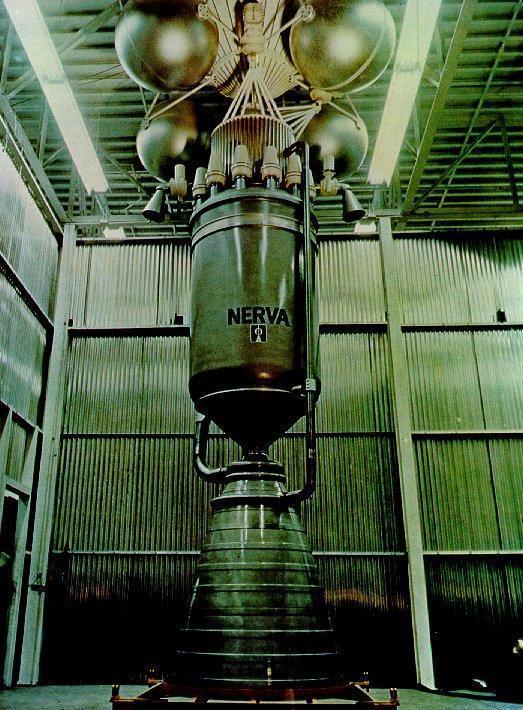
U.S. nuclear engine development occurred in close conjunction with the lunar program, which included a lunar base, so the NERVA-based spacecraft was to be the tug that delivered its components from Earth orbit to orbit around the Moon. It would launch with a nuclear rocket engine as the upper stage of a Saturn rocket, but would operate in space for quite a long time.
These plans were not destined to be realized. At the same time NASA was developing a project of a space shuttle, which soon became the Space Shuttle program, the main purpose of which was to explore low-Earth orbit. This project was much cheaper and more realistic than the lunar exploration program, and the aerospace administration decided to focus on it. All lunar projects including NERVA were closed.
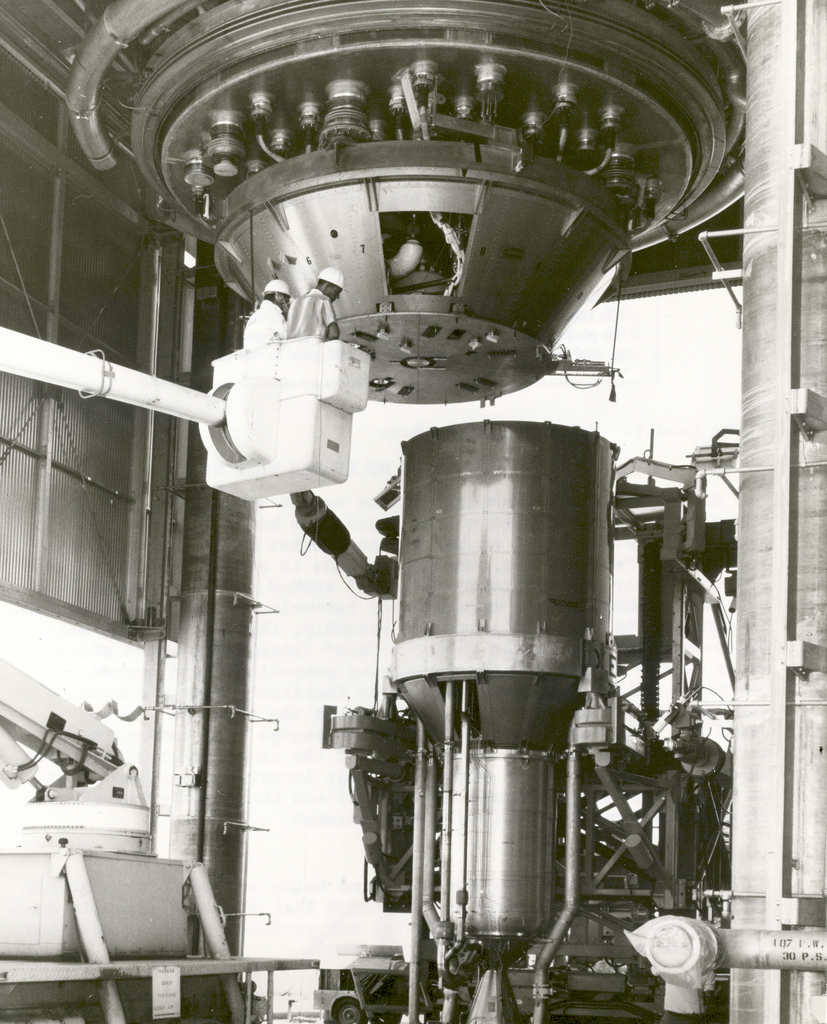
Other countries also experimented with nuclear propulsion. Designs like NERVA were tested in the UK, Italy, Israel, and the USSR. But none of the projects ever got the engines beyond ground testing.
Fission-fragment rocket
The rapid destruction of uranium plates, which prevented the construction of a reliable nuclear engine, led scientists to believe that the element could be used to create thrust. This is how the concept of fissiоn-fragment rocket – a rocket engine based on fission fragments – appeared. The designers decided to refuse to feed the reactor plates with the working fluid at all. But they were disks of carbon filament coated with a layer of uranium and rotated inside a chamber with a coolant, which caused a very rapid corrosion of the material. Particles of disks as a result of nuclear reaction were heated up to temperatures of tens of thousands of degrees and flew through the nozzle with tremendous speed, due to its high density providing a significant specific impulse. Theoretical calculations have shown that the latter can reach 100 thousand seconds.
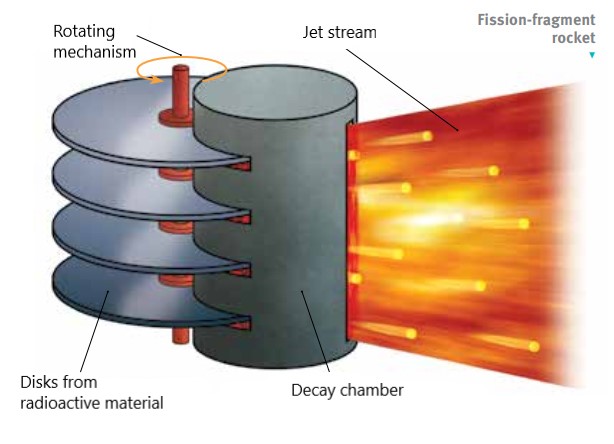
The main problem of such an engine is the high cost of radioactive materials. Of course, no one will use it in the Earth’s atmosphere, but in space the costs of nuclear fuel are too significant. To lower them, in 1987 it was proposed to replace the uranium or plutonium in the disks with americium, a much heavier element that does not occur naturally but can be artificially produced. Its particles have much higher energy during the decay process, which means that much less americium was needed to make the disks for the engine. But the project remained unrealized.
Liquid-phase nuclear engine
Anyway, the efficiency of a nuclear rocket engine is determined by the temperature inside it. But this temperature cannot be increased indefinitely, because at a few thousand degrees even uranium, graphite and tungsten begin to melt. This led to another nuclear engine concept, the liquid-phase engine.
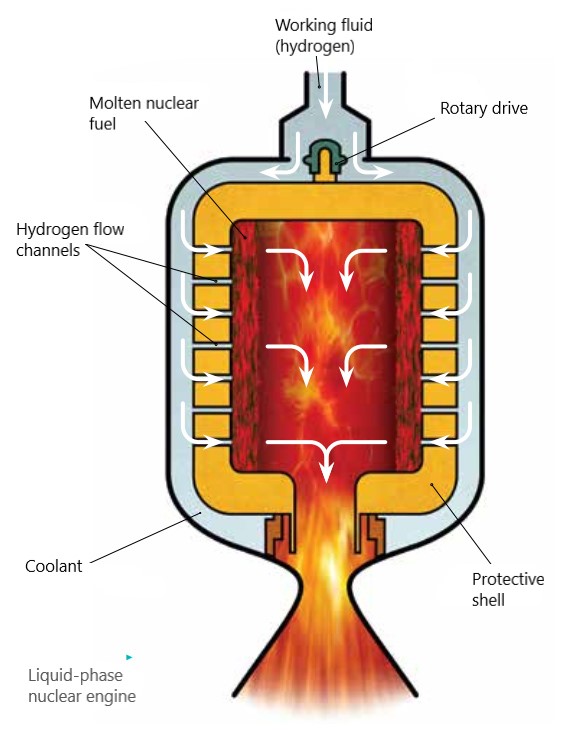
In a liquid-phase nuclear engine, the reactor core is in a liquid state, i.e., in principle, it is designed to operate in a molten state. In fact, this does not interfere with nuclear reactions at all. The only problem is keeping the liquid uranium from flying in all directions and destroying the engine. An even more serious problem is that the working fluid (liquid hydrogen, as in the case of a solid phase engine) will mix with the liquid uranium and thrust will simply not occur.
The solution to these problems is to rapidly rotate the liquid uranium core, whereby centrifugal force throws it away from the engine axis, while the much lighter hydrogen will continue to flow in the middle. Both the rotation and protection of the casing from contact with molten uranium are planned to be accomplished by means of a magnetic field. It is expected that significantly higher temperatures in such an engine will achieve a specific impulse of 1300-1500 s, that is, 13-15 km/ s, which corresponds to the flow rate.
Nuclear salt-water rocket
The above diagram of a liquid-phase engine remains beyond the capabilities of terrestrial engineers today. None of the specialists know how to approach it. That is why in 1991 Robert Zubrin proposed an alternative design, which was called a “nuclear salt-water rocket”.
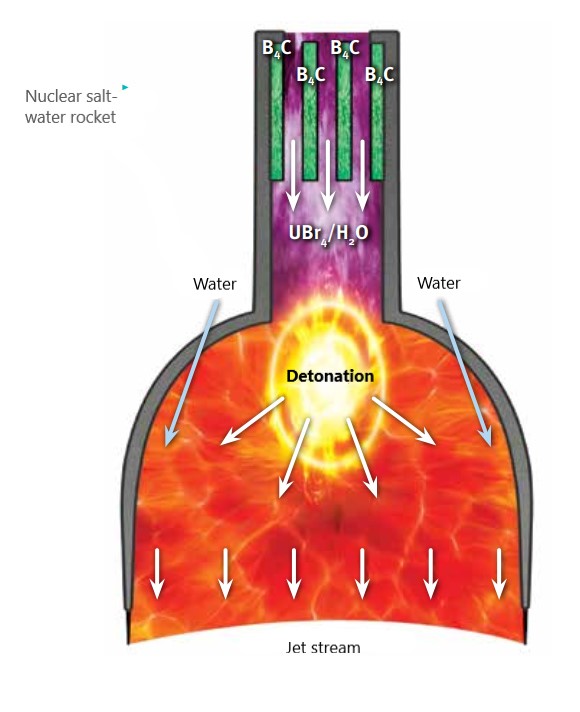
In some ways, this idea is very similar to fissiоn-fragment rocket. The main problem of all conventional nuclear engines is the interaction of the working fluid with the energy-generating assembly of nuclear fuel, which cannot be avoided in both solid-state and liquid-propellant reactors. Therefore, Zubrin proposed to use aqueous solutions of salts of radioactive elements instead of refractory plates. As a result of the nuclear reaction, particles of this fluid reach high temperatures and are ejected outward, creating thrust. Thus, the nuclear fuel also plays the role of a working fluid and accelerates itself.
Because the reactions in Zubrin’s engines take place outside the unit’s body, significantly higher temperatures can be achieved in them than in all nuclear engines created before. Calculations show that the velocity of the working fluid flowing out of the nozzle can be 66-67 km/s, which provides a specific impulse comparable to values that can be obtained only in ion and plasma engines. At the same time, the thrust in such an engine will reach 12 million N, which neither ionic nor plasma engines can provide in the near future.
Although the nuclear salt-water rocket is much simpler than the traditional liquid-phase design, it is still quite unreliable and difficult to control, and requires significant nuclear fuel. The plume from it is highly radioactive, which makes it unacceptable to use such an engine for launch from the Earth’s surface. All of the above shortcomings have meant that in the thirty years since this design has been proposed, not a single experimental design has ever been tested.
Gas-phase nuclear rocket engine
But the possibilities of increasing the efficiency of a nuclear rocket engine are not exhausted even here. It is possible to further raise the temperature inside it and thus increase its specific impulse. However, in this case, the uranium fuel would already be in the gaseous phase. This, once again, does not prevent nuclear reactions, but it is even more difficult to maintain stable operation of such a reactor.
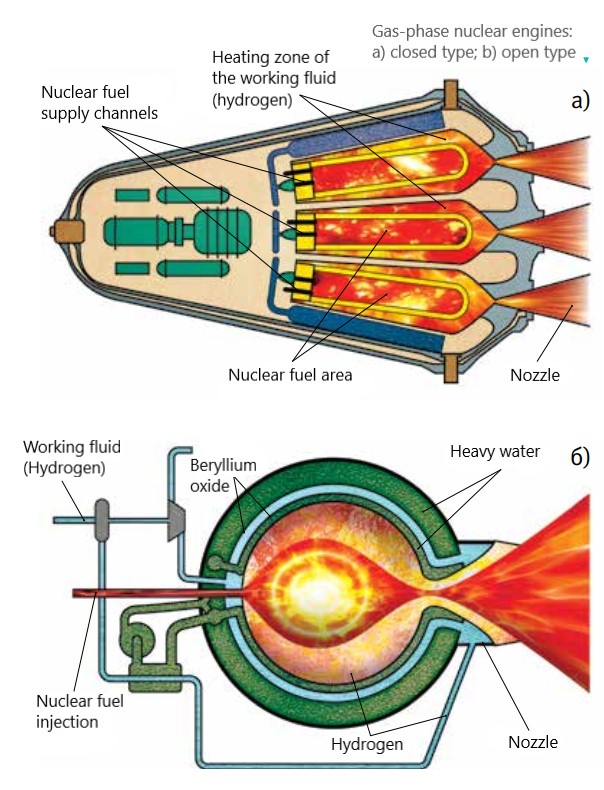
Engineers propose to “spin” gaseous Uranium with a magnetic field to circulate it inside the chamber. And hydrogen gas should flow around it and be accelerated by the heat of the nuclear reaction. Such a design could provide a fantastic specific impulse of 30-50 km/s, but technically it is almost impossible to do so.
An alternative to this method is to keep gaseous uranium inside a quartz container. This design, called a “light bulb”, seems more realistic, but the power and specific impulse in this case is much more modest. The latter, for example, is only 15-20 km/s. In any case, not a single experimental sample of a gas-phase nuclear engine exists today.
Pulsed nuclear rocket engine
There was a little confusion about the name of this type of engine. The fact is that this is sometimes the name of the engine of atomic explosions. However, in 2016, a new solid phase nuclear rocket engine design was proposed, also called the pulse engine, and it is now more commonly understood to be of this type.
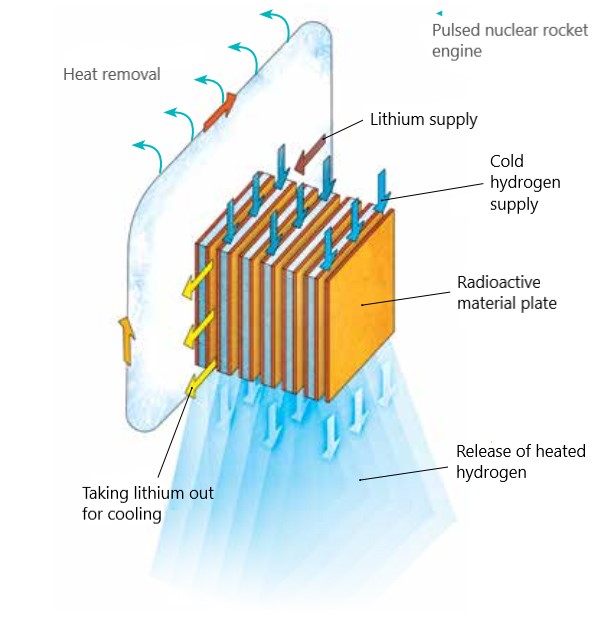
At first glance, this engine is similar to a conventional solid-state reactor with an assembly of fuel elements. It can operate in a conventional nuclear engine mode like NERVA. But it is also available in pulse mode, in which the temperature of the working fluid can reach several thousand degrees Celsius.
This is obtained with the help of neutron pulses. If a nuclear reaction is started very abruptly in a subcritical mass of nuclear fuel, an excessive number of neutrons will be instantly released, which will fly in all directions. In power reactors this development is usually avoided, but research reactors often operate in the pulsed mode, rapidly “turning on” and “turning off” the nuclear reaction.
However, until recently, due to technical peculiarities of such reactors, the frequency of pulses did not often reach higher than one pulse per 10 seconds. However, recently it turned out that when lithium is in the liquid state (and this state comes at relatively low temperatures), it is able to instantly stop the flow of neutrons and thereby quench the nuclear reaction. In addition, lithium is a good coolant. If the cooling line pumps this metal through the reactor in a pulsed mode, the reactor itself begins to operate in a neutron burst mode, which occurs at a frequency of up to several per second.
Neutrons from the burst are absorbed by the hydrogen, which acts as a working fluid, causing its temperature to reach values that can only be achieved in a liquid phase nuclear fuel engine. The fuel remains relatively cold and corrosion is reduced.
Indirect-acting nuclear engines
All of the above types of nuclear engines involve the direct use of nuclear energy. They use the heat energy that resulted from a nuclear reaction to produce acceleration. Besides them, there are also indirect-acting nuclear engines, in which a nuclear reactor is used to generate electric current, and this current powers another type of engine — ion or plasma.
In this case, it is quite difficult to say whether the nuclear reactor belongs to the engine at all, because its power is used not only to power the electromagnetic engine, but also to power all the other systems on board the spacecraft.
In fact, such engines are actually plasma or ion engines and have all their advantages and disadvantages. The only difference is that in this case, it is possible not to save on power. It is particularly successful in combining a nuclear reactor with a plasma engine, which lacks a powerful energy source to reach its potential.
Future of nuclear engines
If we look at the history of nuclear rocket engines, it is clear that, unlike plasma engines, for the last 40 years their designs have not even reached the stage of experimental samples that are tested on Earth. This is despite the fact that a fully working sample of a nuclear engine was obtained back in the 1960s as part of the NERVA project.
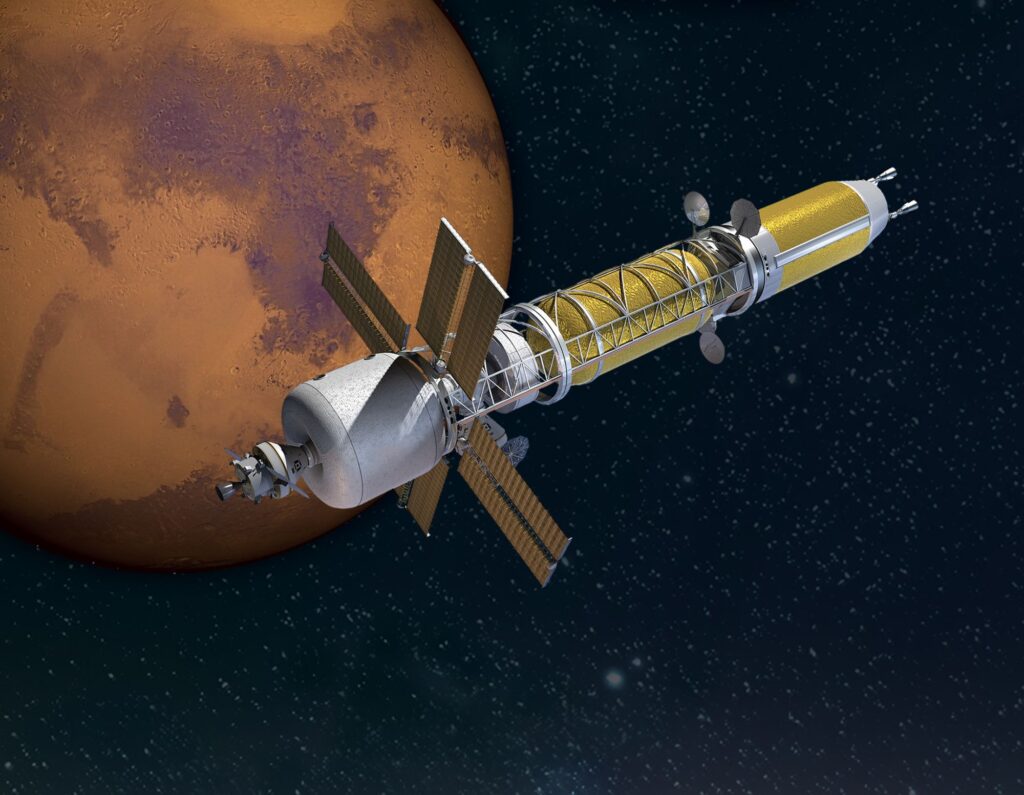
There are several reasons for the prevalence of indirect-acting nuclear engines in laboratories. This is partly due to their complexity. Liquid-phase and gas-phase engines still need engineering expertise that we don’t have. But the main reason for the lack of practical developments is radiophobia. Since the 1960s, people have become more afraid of anything called “atomic”.
It’s worth saying that in some cases these fears are well founded. Two types of nuclear engines that combine realism and extremely high power the fission fragment engine and the nuclear salt-water rocket – can contaminate the atmosphere with long-lived radioactive isotopes as much as the explosion of a nuclear reactor, because, in fact, they are a controlled explosion of such a reactor.
Solid-state nuclear engines also have a certain radioactive emission, but it is rather insignificant. And if not for launch from the surface, then on trajectories to the Moon and other planets they may well be used.
At the same time, the thrust and specific impulse of such engines, which seemed incredible in the 1960s, no longer seem so now. They are quite comparable to the figures for plasma engines that are powered by nuclear reactors. Only time will tell which scheme will prove to be the best. It is quite possible that in 20 years, direct and indirect nuclear engines will be used in parallel.
Author: Candidate of Technical Sciences, Oleksandr Burlaka
This article was published in issue No. 5, 2021, of Universe Space Tech. You can purchase this issue in electronic or paper version in our store.


